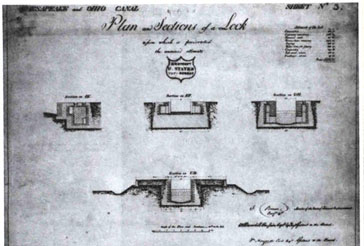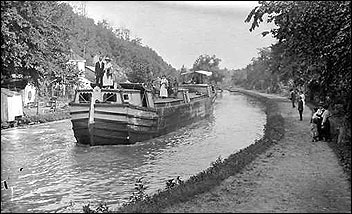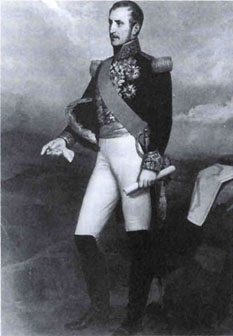On 4 July 1828, President John Quincy Adams turned a spadeful of earth at Little Falls on the Potomac River to initiate the Chesapeake and Ohio (C&O) Canal project, one of the last great public works projects to come out of the early nineteenth century.
 |
| Portion of a Topographical Bureau drawing of a proposed lock on the C&O Canal (Baltimore District History) |
 |
| Early photo of the canal in use (National Park Service Historic Photograph Collection) |
Army engineers had surveyed the route for the C&O Canal in the mid-1820s and their 1826 report had advised building it all the way to Pittsburgh. The estimated cost was about $22 million, an enormous sum for that time. They justified the figure by noting, “When a nation undertakes a work of great public utility, the revenue is not the essential object to take in consideration—its views are of a more elevated order—they are all, and, it may be said, exclusively, directed toward the great and general interests of the community.” The engineers argued that any revenues derived from the canal (a matter of considerable interest to the canal company) were “. . . of merely secondary importance for the nation.” Rather, the canal would testify to the glory of the nation—even though it would saddle the canal company with enormous debt. Just the first part of the canal, stretching 184 miles from Washington, D.C. to Cumberland, Maryland, would cost nearly $9 million, according to the Army engineer report.
Outraged investors and politicians called for another survey, this time by a group of engineers led by two who had worked on the Erie Canal. These gentlemen craftsmen, much admired but ignorant of formal engineering theory, determined that the canal to Cumberland could be built for less than half the Army’s estimate. They cut the width from 60 to 40 feet, left the bed of the river unlined, and estimated excavation costs to be about 5 cents per cubic yard, compared to the Army’s estimate of 14 cents per cubic yard. Congress, investors, and state and local officials were delighted, and construction got underway.
But when the canal to Cumberland was finally completed in 1850, the cost was more than $2 million higher than even the Army’s estimate. Chastised directors of the canal company hearkened back to the beginning of the project and explained, “A body of men, however upright and intelligent, are easily satisfied of what they greatly wish to believe. The elaborate, well digested, and disinterested estimates of a corps of the ablest engineers in America guided by the matured experiences of one who had distinguished himself at the [French] Polytechnic School . . . were thus cast aside and condemned." In this way, the directors praised both the Corps and Simon Bernard, one of Napoleon's best engineers, who had received a commission as brigadier general in the Corps of Engineers in 1816 and for more than fourteen years influenced Corps work in both fortifications and rivers and harbors construction.
 |
Brig. Gen. Simon Bernard
(Casemate Museum, Ft. Monroe) |
 |
| Present day photo of the canal lock in Georgetown (D.C. SHPO) |
Nevertheless, there is probably a grain of truth in the charge that the Army over-engineered the project. “We were planning a work for the nation,” wrote Army engineer officers in their 1826 report, and “it did not belong to us to curtail the cost in order to derive from the capital a greater interest. . . to the detriment of durability and conveyancy.” The Army Corps of Engineers thought in terms of grand works of improvement that would knit together the new nation, promoting both political stability and commercial development. In today’s environment, with conflicting and numerous demands on limited funds, Army engineers are far more sensitive to financial constraints. Still, the emphasis on the value, indeed the necessity, of a transportation network for national greatness remains part of the culture of the Corps of Engineers. When Army engineers claim they have a role to play in repairing and replacing America’s infrastructure, they use as evidence two centuries of experience in building the nation and, in so doing, contributing to its strength and unity.
* * *
July 2003